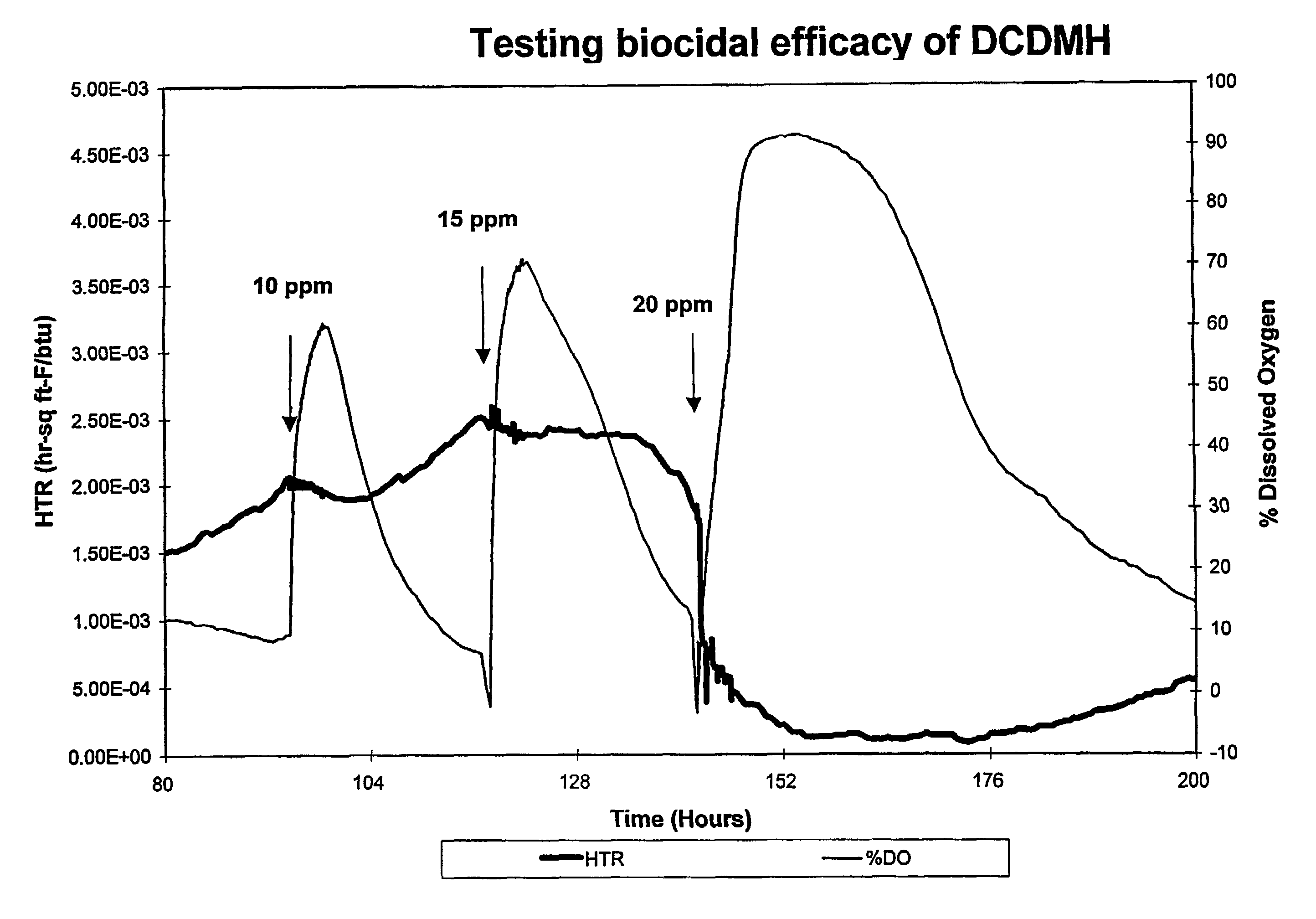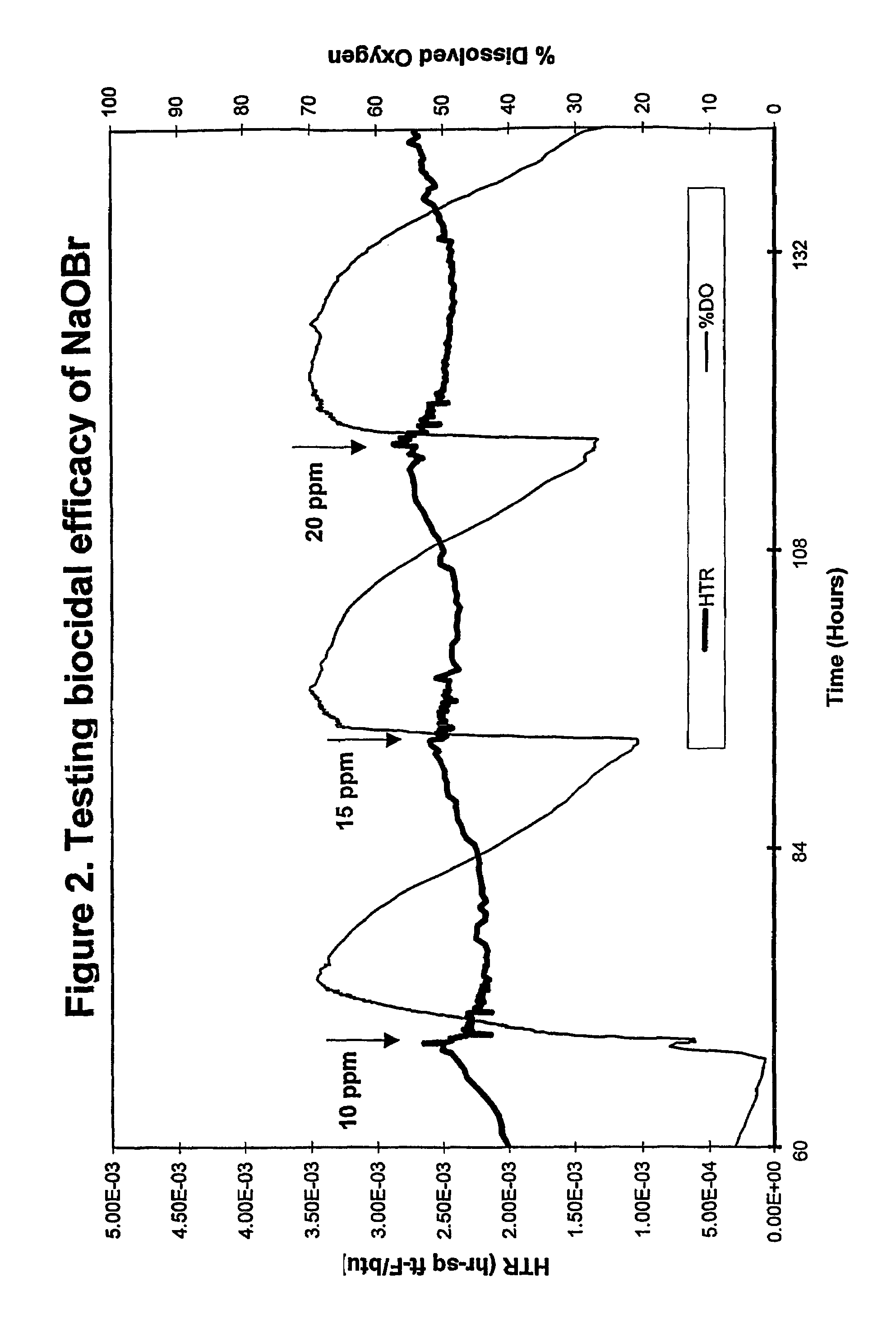Method for removal of biofilm
a biofilm and biofilm technology, applied in the field of biofilm removal, can solve the problems of affecting the effect of biofilm removal
- Summary
- Abstract
- Description
- Claims
- Application Information
AI Technical Summary
Benefits of technology
Problems solved by technology
Method used
Image
Examples
example 1
Biofilm Inhibition Control Efficacy
[0032]The efficacy of biocides and biocides with dispersants was estimated by a reduction of biofilm dry weight in test flasks, compared to untreated controls. Biofilm development was determined gravimetrically by the methods described in Ludyansky, M., Colby, S., A Laboratory Method for Evaluating Biocidal Efficacy on Biofilms, Cooling Tower Institute, Paper TP96-07 (1996).
[0033]The sheathed Sphaerotilus natans (ATCC 15291), which is known to be very resistant to any chemical control and found in a variety of applications (cooling water systems, paper process waters, and sewage treatment processes), was used in the tests.
[0034]The bacteria were cultivated at 25-30° C. in a 5% CGY medium which contained: 5 g of casitone (Difco), 10 g of glycerol, and 1 g of yeast autolysate (Difco) per liter of DI water. The inocula contained approximately 106 cells per milliliter. 8 oz. flasks were filled with 150 ml of 5% CGY media and 1 ml of Sphaerotilus natans...
example 2
Biofilm Removal Control Efficacy
[0038]Sphaerotilus natans (ATCC 15291), as in Example 1, was used in the tests described below.
Biofilm Test System
[0039]An on-line testing system for chlorinated biocide efficacy testing was used to provide a real-time, non-destructive method for biofilm monitoring and measurement. The system monitors the heat transfer resistance (HTR) which correlates to biofilm formation and accumulation, and dissolved oxygen (DO) level in the bulk water which correlates with changes in biofilm activity. The system design, parameters and growth conditions are disclosed in Ludensky, M., “An Automated System for Biocide Testing on Biofilms.”Journal of Industrial Microbiology and Biotechnology, 20:109-115 (1998).
[0040]The system consisted of a continuous-flow heat-exchange loop, a biological growth reactor (chemostat) and subsystems for life support, biofilm measurement, and environmental control. All system parameters, including water flow, temperature, dilution rate ...
example 3
[0052]This example demonstrates the enhanced photostability of MCDMH as compared to NaOCl when test solutions thereof are exposed to simulated sunlight.
[0053]Test solutions were prepared by adding to tap water having a temperature of 22° C. and a pH of 7.8 NaOCl and MCDMH at the concentrations indicated in Table 4 below. These solutions were illuminated by UVA-340 fluorescent lights that simulate the spectral radiance of the sun at the surface of the earth. The test samples were covered with quartz plates, transparent to ultraviolet light, to prevent evaporation. Total halogen concentrations were measured as a function of time. The generated active halogen decay curves were analyzed using first order kinetic algorithms and the corresponding active halogen half-lives calculated. The results are shown in Table 4.
[0054]As shown in Table 4, MCDMH provides dramatically superior photostability to NaOCl. The observed active halogen half-life for MCDMH was 108 hours compared to 1.1 hour for...
PUM
| Property | Measurement | Unit |
|---|---|---|
| pH | aaaaa | aaaaa |
| temperature | aaaaa | aaaaa |
| aqueous | aaaaa | aaaaa |
Abstract
Description
Claims
Application Information
 Login to View More
Login to View More - R&D
- Intellectual Property
- Life Sciences
- Materials
- Tech Scout
- Unparalleled Data Quality
- Higher Quality Content
- 60% Fewer Hallucinations
Browse by: Latest US Patents, China's latest patents, Technical Efficacy Thesaurus, Application Domain, Technology Topic, Popular Technical Reports.
© 2025 PatSnap. All rights reserved.Legal|Privacy policy|Modern Slavery Act Transparency Statement|Sitemap|About US| Contact US: help@patsnap.com



